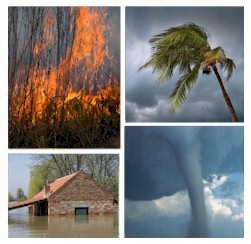|
|


Emergency Response Systems
 This section of our technical library presents articles written about Emergency Alert Systems and Disaster Recovery definitions, terms and related information.
This section of our technical library presents articles written about Emergency Alert Systems and Disaster Recovery definitions, terms and related information.
The 911Broadcast emergency notification and alert service can deliver a large number of phone calls using a network of phone systems employing digital phone lines simultaneously. Should a disaster such as a snow storm, wild fire or flood hit your area, 911Broadcast systems can alert your community quickly providing specific instructions if an evacuation is required.
This service is available using our emergency broadcasting systems. If a dangerous chemical spill occurs in your community, you can target specific areas to call. If a severe snow storm hits your area, your community can be notified of school closings or event cancellations.
Feds to share emergency response system
Seattle first to link to federal response center for biological, chemical and nuclear threats
By Heather Hayes
Within a day of the Sept. 11 terrorist attacks on New York City and Washington, D.C., politicians and intelligence officials began publicizing the types of threats the country faces. Topping the chilling list are various chemical weapons, dirty bombs containing radiological material and biological agents potentially dispersed from commandeered crop-dusters.
Not surprisingly, local officials immediately began to worry about their ability to respond effectively to such calamities.
"Cities and counties were suddenly going to be the first responders for homeland defense, and there was just this feeling of vulnerability," said Ronda Mosley-Rovi, director of environmental programs for Public Technology Inc., which is the technology arm of the National League of Cities, the National Association of Counties and the International City/County Management Association. "We got so many phone calls asking for help."
Fortunately, help was already on the way. A partnership between PTI and the National Nuclear Security Administration — set up well before the terrorist attacks — will soon provide local emergency response agencies with Internet-based access to the National Atmospheric Release Advisory Center (NARAC) at Lawrence Livermore National Laboratory.
Established in 1979, NARAC is an emergency response center that provides planning, real-time assessments and detailed studies of chemical, biological and radiological releases to the Energy and Defense departments. Since its inception, the center has responded to more than 160 alerts, accidents and disasters.
Working with cities and counties, NARAC scientists can draw on a massive database containing information on every conceivable chemical and biological agent and the consequences of various interactions. In an emergency, they would run that information against current weather and terrain data to map the likely spread of contamination. They would immediately provide that analysis to local emergency managers, giving them a critical head start on determining and directing protective action.
"The goal here is to act quickly and have the best possible situation awareness available to people on the ground so that we can save lives," said Donald Ermak, leader of the lab's Atmospheric Release Assessment Program. "If you're talking about something that has immediate effects — like many of the chemical agents — this would help firefighters and other emergency personnel understand where the victims are going to be and what levels of effect they can expect, such as lethal doses, sick people or people suffering only from irritated skin or eyes."
Known as LINC, which stands for the Local Integration of NARAC with Cities, the new program is being tested at a site in Seattle, with at least a half-dozen additional cities to be added in the next year. Officials hope to begin distributing the program across the country in early 2005.
Seattle officials are eager to participate. "The feds are offering us some of their infinite resources, which include one of the biggest computers in the world and the best information as to how contaminants move in the winds and the atmosphere and the weather," said Tim Croll, community services director for Seattle Public Utilities and local director of the LINC program. "We'll have the best expertise in the world at our disposal."
NARAC personnel are installing custom Java-based software, called iClient, on computers that the Seattle emergency response team that is participating in the pilot project will use. This software will serve as the local front end to NARAC's systems.
They are also developing a software link that will enable NARAC's data products to be transmitted and superimposed on the maps stored and managed by Seattle's geographic information system.
Officials expect LINC to be operational by the end of the summer, with training planned for this summer and testing of potential scenarios occurring in the fall.
Ultimately, Croll said, LINC will be available at Seattle's Fire Department Mobile Command Center, the city's Emergency Operations Center and, hopefully, in a mobile hazardous materials response unit. He expects four firefighters to be trained and certified to use the system.
Croll said that one proposed plan would have the results of the software's calculations posted on a Web site and accessible to authorized city, state and federal personnel.
Observers see several benefits of the LINC program. For starters, it offers critical, real-time information that helps local workers manage the aftermath of any type of hazardous release and respond as effectively as possible.
If there is no obvious release but large numbers of people start getting sick, the program can help officials work backward to determine the contaminant and then use a forecasting capability to minimize the number of additional victims. LINC can also help train local personnel for "what if" scenarios.
As the Seattle pilot project continues, PTI and NARAC officials have begun looking for other potential test cities, seeking a diversity of size and geography in their selection. The goal is to eventually transfer the capability to the state and regional levels.
Long-term funding remains a concern, PTI's Mosley-Rovi said. DOE officials are committed to backing the program for the next three years, but ultimately they would like LINC to be self-sustaining. "We're looking at a number of options," she said, noting that the Federal Emergency Management Agency or even the federal Homeland Security Office are potential candidates for picking up part or all of the tab. "But we've got time to figure it all out."
Meanwhile, officials hope the Seattle project will silence any doubts about LINC's ability to help handle biological, chemical and radiological threats.
"There's nothing new theoretically at work here because this has been done for years at different nuclear stations," Croll said. "We're just taking it the last couple of steps. [DOE officials are] being very smart here, making this available for the local jurisdictions that will be the first responders when the next attack comes. We're grateful to have it."
Hayes is a freelance writer based in Stuarts Draft, Va. She can be reached at hbhayes@cfw.com.
Activating Your Emergency Broadcasts
DSC systems allow you to initiate an emergency broadcast using several methods. Because emergencies can arise at any hour of the day or night, we have provided these multiple techniques so that you are not required to staff a center 24 by 7.
- Emergency Control Center
- DSC provides an Emergency Control Center PC interface to our phone systems that manages one emergency phone dialer or an entire network of dialers. Our emergency control program runs either on your local dialer or on the network where your dialer resides. This program lets you download phone lists and emergency phone messages and initiate the emergeny broadcast.
This program likewise lets you configure your network or emergency dialers and produces reports on the performance of your system or network.
- Web Based Control Center
- Our web based emergency notification system lets you access a web page for managing and activating emergency broadcasts. After entering a secure user id and password, you can download phone lists and recorded emergency messages. Using a menu selection, you can select any phone list/message combination to be broadcast online and initiate the emergency alert.

- Phone Activated Emergency Dialing
- If you are not able to access the internet and use our web based emergency dialing interface, we allow you to initiate an emergency phone campaign using a simple touchphone into our phone system.
After properly validating your account id and password, the phone system lets you select a pre-recorded messsage (or record one while you are on the phone). It then prompts you to identify the list of phone numbers to be called (previously maintained under your account). Finally this phone program will let you listen to the message to be sent and inform you of the size of the list of numbers to be called as a final check. If everything is ok, then pressing a touchphone key activates the calling program.
- Computer Activated Dialing
- Our emergency notification network also supports computer and web connectivity using XML technology. Thus, emergency communication can be initiated from your website or computer by automatically sending our emergency phone system a message containing a list of one or more phone numbers and a message to be sent to these individuals. The message can be text (which is automatically converted to voice) or a voice file.
For further information, visit our Emergency XML messaging web page.
|




 This section of our technical library presents articles written about Emergency Alert Systems and Disaster Recovery definitions, terms and related information.
This section of our technical library presents articles written about Emergency Alert Systems and Disaster Recovery definitions, terms and related information.
